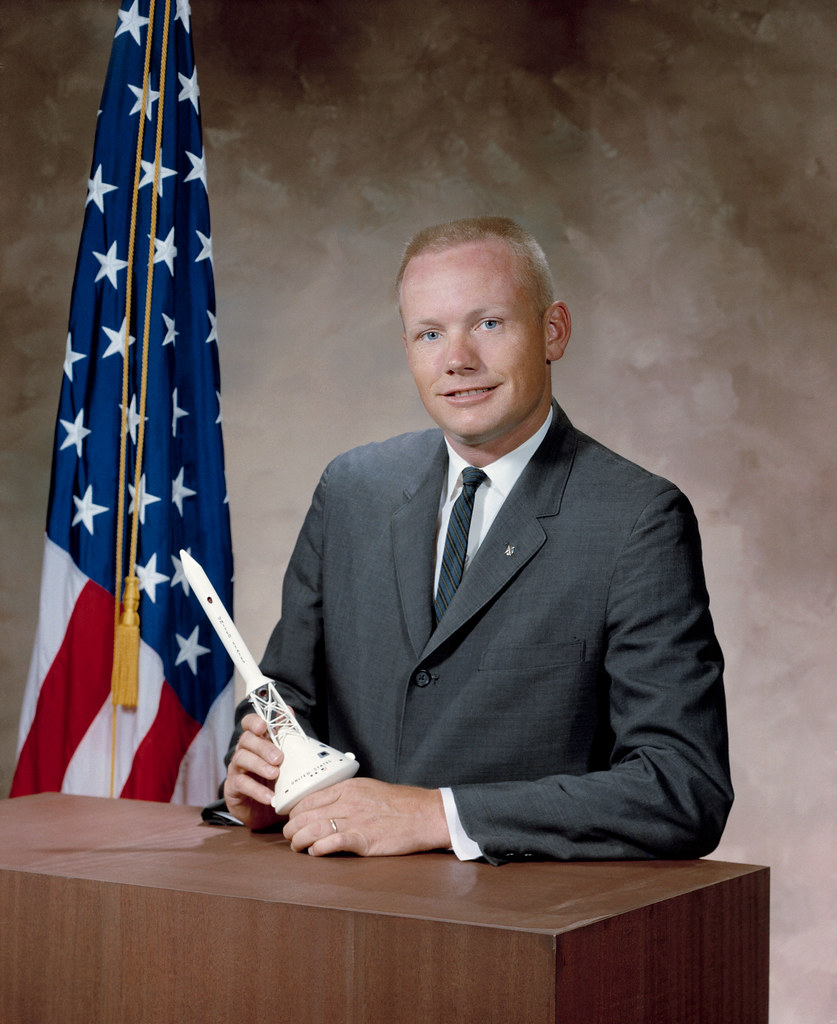
Описание: S64-31453 (1964) --- Astronaut Neil A. Armstrong. [ NASA Armstrong Fact Sheet: Neil A. Armstrong ] NASA's Armstrong Flight Research Center in Edwards, California, was named in honor of Neil A. Armstrong, best known as the commander of NASA's Apollo 11 mission, during which he became the first person to set foot on the moon on July 20, 1969. Previously known as the Hugh L. Dryden Flight Research Center, the center was renamed in 2014 to reflect Armstrong’s contributions to aeronautics. Armstrong is NASA's premier site for aeronautical flight research. The center also uses airplanes to conduct airborne environmental and Earth science; it employs a 747 aircraft with a telescope to perform astronomical science missions based out of its satellite facility in Palmdale, California. Neil Armstrong was born Aug. 5, 1930, in Wapakoneta, Ohio. He served as a naval aviator from 1949 to 1952 and joined the National Advisory Committee for Aeronautics (NACA) in 1955. In 1958 NACA transitioned to NASA, and he continued to serve as an engineer, research pilot, astronaut and administrator. As a research pilot, Armstrong participated in both piloting and engineering aspects of numerous projects, including the X-15 hypersonic rocket plane. He piloted the first flight of an X-15 aircraft equipped with a new airflow-direction sensor in its nose, as well as the initial flight of an X-15 equipped with a self-adaptive flight control system. He worked closely with designers and engineers to develop the adaptive system, and made seven flights in the rocket plane between December 1960 and July 1962. During those flights he reached a peak altitude of 207,500 feet in the X-15-3, and a speed of 3,989 mph (Mach 5.74) in the X-15-1. Armstrong also served as project pilot for research projects flown on the F-100A and F-100C aircraft, F-101, and the F-104A. He was the second pilot to fly the X-1B with an active reaction control system. He also flew the X-5, F-105, F-106, B-47, KC-135, and Paresev. He was a member of the USAF-NASA Dyna-Soar Pilot Consultant Group before the Dyna-Soar project was canceled and studied X-20 Dyna-Soar approaches and abort maneuvers using F-102A and F5D aircraft. Armstrong transferred to astronaut status in 1962. He was assigned as command pilot for the Gemini 8 mission that launched on March 16, 1966. On that mission, he performed the first successful docking of two vehicles in space. As spacecraft commander for Apollo 11, the first manned lunar landing mission, Armstrong gained the distinction of being the first man to land a craft on the moon and first to step on its surface. A lunar landing training vehicle was tested and modified at the center that is now his namesake; Apollo astronauts used these to prepare for landing on the moon. Armstrong subsequently held the position of Deputy Associate Administrator for Aeronautics, NASA Headquarters, Washington, D.C. In this position, he coordinated and managed the overall NASA research and technology work related to aeronautics. The Digital Fly-by-Wire control system for aircraft was among the technologies he helped transfer to industry. He held a professorship of aerospace engineering at the University of Cincinnati in Ohio between 1971-1979. During the years 1982-1992, Armstrong was chairman of Computing Technologies for Aviation, Inc. in Charlottesville, Virginia. He earned a Bachelor of Science Degree in Aeronautical Engineering from Purdue University in 1955 and a Master of Science in Aerospace Engineering from the University of Southern California as well as honorary doctorates from a number of universities. Armstrong was a Fellow of the Society of Experimental Test Pilots and the Royal Aeronautical Society; Honorary Fellow of the American Institute of Aeronautics and Astronautics, and the International Astronautics Federation. He was decorated by 17 countries and received numerous special honors. Armstrong passed away, at the age of 82, on Aug. 25, 2012, following complications resulting from cardiovascular procedures.
Tags:
Поиск и фотоизображения предоставлены компанией Flickr с помощью сервиса Flickr API согласно Правилам пользования сайтом Flick.com и его сервисами. Графические изображения являются публичными, размещёнными их авторами в свободный доступ (Public) и физически расположены на серверах Flickr. Все права на фотографии принадлежат их авторам согласно пользовательскому соглашению сервиса Flickr.com и охраняются законами, регулирующими авторские права.